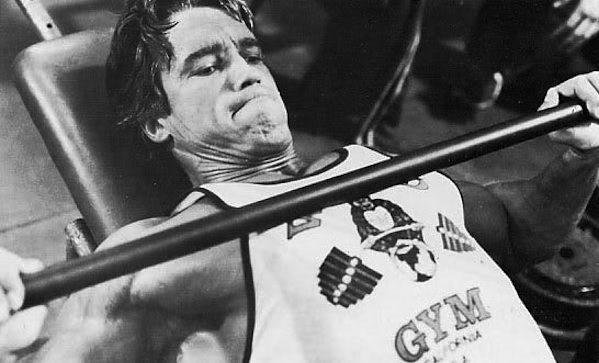Are you an efficient, well-adjusted lifter? Yes, chest day is the best day of the gym junkie’s week and is rarely skipped. The good news is, your one rep max bench press will set the benchmark in order to quantify your level of development over all. Here’s the question: does the rest of your body measure up? These are the seven major movements that all need to be balanced for a well-rounded torso. Each addresses the seven major upper body muscle groups.
1: Biacromial bench press
(pectoralis major – 100 per cent)
Sounds intense I know, but biacromial refers to your grip on the bar and nothing more.
Your one repetition maximum (RM) of this exercise dictates what your one RMs will be for the following movements. It is the 100 per cent benchmark. A good starting point would be a 135-pound bench press (that’s one full plate on a standard 45 pound Olympic bar). Each following example will be calculated as if your biacromial press one RM was 135 pounds.
For the correct grip, lie on the flat bench press and extend your arms straight up to the ceiling like Frankenstein’s monster. Where the middle of your wrist makes contact with the Olympic bar is where your index finger will go. That means in the stretched position of the movement (bottom), your index knuckle will meet your armpit (the origin of your pectoralis major). The bar will be at nipple height on your torso and your humerus bone is on a 45-degree angle from your medial line (the line down the middle of your body).
2: Dips
(triceps – 117 per cent)
This is the only movement that you should be able to lift more than your biacromial press, and will ultimately test your triceps’ strength.
Your one RM on this exercise should be 17 per cent more than that of your biacromial press.
If your biacromial press is 135 pounds, then your dip max, which will include your body weight of course, should be 158 pounds. If it is less, your triceps are behind. If it is more, your pecs have fallen behind.
Supported by two parallel bars, bend at the elbow until you reach a 90-degree angle in the joint. Avoid internal rotation at the shoulders and keep your knees below your body by flexing your gluteus maximus (your butt) and your transverse abdominis (your core, like doing a plank).
3: Incline press
(pectoralis minor – 81 per cent)
Your chest has two primary muscle groups and this movement involves the secondary group: the pectoralis minor.
Your one RM here should be 81 per cent of the one RM weight lifted in your flat biacromial press. In our 135-pound biacromial press example, your incline press should be 110 pounds.
The bench should be on a 45-degree angle to the floor and you will be using an Olympic bar again. Your grip will be the same biacromial grip as the flat bench press, heels beneath your knees and your transverse abdominis flexed.
4: Chin-ups
(latissimus dorsi – 87 per cent)
This is the butterfly muscle in your back that gives you that upside down triangular torso.
Your one RM here should be 87 per cent of the one RM weight lifted in your flat biacromial press. In our example case of a 135-pound biacromial press, your chin-up should be 118 pounds. Just like the dips, this includes your body weight.
Your hands face your face (supinated, any other grip is a pull up). Keep your knees beneath your hips by flexing your gluteus maximus and your transverse abdominis. A full contraction means your chin passed the bar and your biceps met your forearms.
5: Reverse curls
(biceps brachii [longhead] – 35 per cent)
Your bicep brachii has two heads. This movement will measure the long head.
Your one RM for this movement should be 35 per cent of the one RM weight lifted in your flat biacromial press. In our example case of a 135-pound biacromial press, your reverse curl should be 48 pounds.
Your grip will be pronated (palms down) hence the name, on an EZ bar. Stand with your back against the wall to avoid swinging. Your forearm must meet your bicep to complete the movement.
6: Scott curls
(biceps brachii [shorthead] – 46 per cent)
The scott curl calls for an externally rotated supinated grip which will recruit the short head of your biceps brachii.
Your one RM for this movement should be 46 per cent of the one RM weight lifted in your flat biacromial press. In our example case of a 135-pound biacromial press, your scott curl should be 63 pounds.
The movement requires an EZ bar for the appropriate external rotation. Descend to 170 degrees (just before your arm is completely straight) and lift until your forearm meets your bicep.
7: Seated military press
(deltoids – 66 per cent)
This is the movement that will measure your deltoid strength located in your shoulders.
Your one RM for this movement should be 66 per cent of the one RM weight lifted in your flat biacromial press. In our example case of a 135-pound biacromial press, your military press should be 90 pounds.
Once again you will be working with an olympic standard bar. At the stretched (bottom) position of the movement, if you were to stick your thumbs towards your body, they must meet your shoulders. Your feet are directly beneath your knees and your core is activated.
____________
Iain Bain grew up in the fitness industry with a father who was a competitive bodybuilder. After high school, he studied journalism at Ryerson University. Now he’s applying both of those passions in one as a certified strength coach. You can find him on Twitter @thebainbuild, so don’t hesitate to reach out with questions as you have them!


